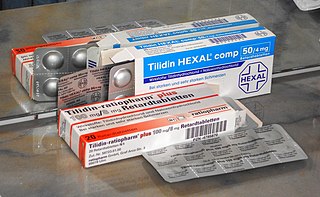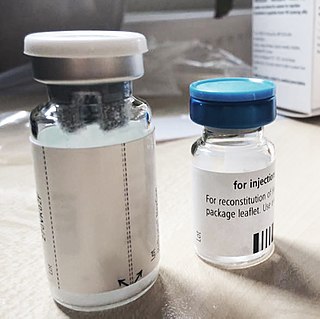Related Research Articles

The United States Food and Drug Administration is a federal agency of the Department of Health and Human Services. The FDA is responsible for protecting and promoting public health through the control and supervision of food safety, tobacco products, dietary supplements, prescription and over-the-counter pharmaceutical drugs (medications), vaccines, biopharmaceuticals, blood transfusions, medical devices, electromagnetic radiation emitting devices (ERED), cosmetics, animal foods & feed and veterinary products.

A medication is a drug used to diagnose, cure, treat, or prevent disease. Drug therapy (pharmacotherapy) is an important part of the medical field and relies on the science of pharmacology for continual advancement and on pharmacy for appropriate management.
An orphan drug is a pharmaceutical agent developed to treat medical conditions which, because they are so rare, would not be profitable to produce without government assistance. The conditions are referred to as orphan diseases.
Sexual dysfunction is difficulty experienced by an individual or partners during any stage of normal sexual activity, including physical pleasure, desire, preference, arousal, or orgasm. The World Health Organization defines sexual dysfunction as a "person's inability to participate in a sexual relationship as they would wish". This definition is broad and is subject to many interpretations. A diagnosis of sexual dysfunction under DSM-5 requires a person to feel extreme distress and interpersonal strain for a minimum of six months. Sexual dysfunctions can have a profound impact on an individual's perceived quality of sexual life. The term sexual disorder may not only refer to physical sexual dysfunction, but to paraphilias as well; this is sometimes termed disorder of sexual preference.

Cosmetology is the study and application of beauty treatment. Branches of specialty include hairstyling, skin care, cosmetics, manicures/pedicures, non-permanent hair removal such as waxing and sugaring, and permanent hair removal processes such as electrology and intense pulsed light (IPL).

The United States Federal Food, Drug, and Cosmetic Act is a set of laws passed by Congress in 1938 giving authority to the U.S. Food and Drug Administration (FDA) to oversee the safety of food, drugs, medical devices, and cosmetics. A principal author of this law was Royal S. Copeland, a three-term U.S. Senator from New York. In 1968, the Electronic Product Radiation Control provisions were added to the FD&C. Also in that year the FDA formed the Drug Efficacy Study Implementation (DESI) to incorporate into FD&C regulations the recommendations from a National Academy of Sciences investigation of effectiveness of previously marketed drugs. The act has been amended many times, most recently to add requirements about bioterrorism preparations.

Velvet antler is the whole cartilaginous antler in a precalcified growth stage of the Cervidae family including the species of deer such as elk, moose, and caribou. Velvet antler is covered in a hairy, velvet-like "skin" known as velvet and its tines are rounded, because the antler has not calcified or finished developing. Velvet antler preparations are sold in China as part of traditional Chinese medicine, and in the United States and some other countries as a dietary supplement.
Cosmeceuticals are cosmetic products with bioactive ingredients purported to have medical benefits. There are no legal requirements to prove that these products live up to their claims. The name is a portmanteau of "cosmetics" and "pharmaceuticals". "Nutricosmetics" are related dietary supplement or food or beverage products with additives that are marketed as having medical benefits that affect appearance.
The Food and Drugs Act is an act of the Parliament of Canada regarding the production, import, export, transport across provinces and sale of food, drugs, contraceptive devices and cosmetics. It was first passed in 1920 and most recently revised in 1985. It attempts to ensure that these products are safe, that their ingredients are disclosed and that drugs are effective and are not sold as food or cosmetics. It also states that cures for disease listed in Schedule A, cannot be advertised to the general public.
Contaminated haemophilia blood products were a serious public health problem in the late 1970s up to 1985.
Numerous governmental and non-governmental organizations have criticized the U. S. Food and Drug Administration for alleged excessive and/or insufficient regulation. The U.S. Food and Drug Administration (FDA) is an agency of the United States Department of Health and Human Services and is responsible for the safety regulation of most types of foods, dietary supplements, drugs, vaccines, biological medical products, blood products, medical devices, radiation-emitting devices, veterinary products, and cosmetics. The FDA also enforces section 361 of the Public Health Service Act and the associated regulations, including sanitation requirements on interstate travel as well as specific rules for control of disease on products ranging from animals sold as pets to donations of human blood and tissue.
The history of condoms goes back at least several centuries, and perhaps beyond. For most of their history, condoms have been used both as a method of birth control, and as a protective measure against sexually transmitted diseases. Condoms have been made from a variety of materials; prior to the 19th century, chemically treated linen and animal tissue are the best documented varieties. Rubber condoms gained popularity in the mid-19th century, and in the early 20th century major advances were made in manufacturing techniques. Prior to the introduction of the combined oral contraceptive pill, condoms were the most popular birth control method in the Western world. In the second half of the 20th century, the low cost of condoms contributed to their importance in family planning programs throughout the developing world. Condoms have also become increasingly important in efforts to fight the AIDS pandemic. The oldest condoms ever excavated were found in a cesspit located in the grounds of Dudley Castle and were made from animal membrane. The condoms dated back to as early as 1642.

The regulation of food and dietary supplements by the U.S. Food and Drug Administration is a process governed by various statutes enacted by the United States Congress and interpreted by the U.S. Food and Drug Administration ("FDA"). Pursuant to the Federal Food, Drug, and Cosmetic Act and accompanying legislation, the FDA has authority to oversee the quality of substances sold as food in the United States, and to monitor claims made in the labeling about both the composition and the health benefits of foods.

Rotula aquatica is a species of aromatic flowering shrub in the borage family, Boraginaceae. It is a rare rheophyte native to India, where it is a member of the lotic ecosystem of streams.

The contaminated blood scandal in the United Kingdom arose when at least 3,891 people, most of whom suffered from haemophilia, became infected with hepatitis C of whom 1,243 were also infected with HIV, the virus that leads to acquired immune deficiency syndrome (AIDS), as a result of receiving contaminated clotting factor products supplied by the National Health Service (NHS) in the 1970s and 1980s. As of October 2017 there were at least 1,246 confirmed deaths in the UK of people who were killed by the use of contaminated Factor VIII and Factor IX clotting agents and the viruses they transmitted. Some have estimated that the total number of those who have died could be as high as 2,400 though exact figures are not known.
This article is about the history of the United States Food and Drug Administration.

The Drugs and Magic Remedies Act, 1954 is an Act of the Parliament of India which controls advertising of drugs in India. It prohibits advertisements of drugs and remedies that claim to have magical properties, and makes doing so a cognizable offence.
The Drugs and Cosmetics Rules, 1940 are the rules which the government of India established through the Drugs and Cosmetics Act, 1940. These rules classify drugs under given schedules and present guidelines for the storage, sale, display and prescription of each schedule.

A botanical drug is defined in the United States Federal Food, Drug, and Cosmetic Act as a botanical product that is marketed as diagnosing, mitigating, treating, or curing a disease; a botanical product in turn, is a finished, labeled product that contains ingredients from plants. Chemicals that are purified from plants, like paclitaxel, and highly purified products of industrial fermentation, like biopharmaceuticals, are not considered to be botanical products.
References
- 1 2 "Drugs and Cosmetics Act, 1940" (PDF). Central Drugs Standard Control Organization. Archived from the original (PDF) on 31 October 2005. Retrieved 19 February 2015.
- ↑ "HC restrains manufacture, marketing of Immuno-QR". The Hindu . 21 December 2001. Archived from the original on 21 February 2015. Retrieved 21 February 2015.